As we embark on the fourth and final post of our sentence skills series, we’re unveiling seven simple, yet impactful approaches to incorporate sentence-level writing into your upper elementary classroom.
If you’ve been following our journey over the past three weeks, you’ve gained insights into the importance of sentence-level writing, strategies to enhance students’ sentence construction, and the art of sentence deconstruction. And if you haven’t had the chance to read our previous posts in this series, I encourage you to check them out – each post is packed full of ways to improve your student’s sentence skills:
- Sentence-Level Writing: Why Upper Elementary Teachers Need to Prioritize This Skill
- Sentence Expansion Activities: Empower Students to Add Details with Impact
- Sentence Deconstruction: A Powerful Tool for Building Stronger Readers
Today’s post is going to bring it all together – it’s time to translate the insights from the last several weeks into actionable steps and make sentence-level work an integral part of your daily instructional routine.
Sentence-Writing Routine as a Warm-Up:
To ignite your writing block, consider introducing a sentence-writing routine as a warm-up. Routines offer the structure and consistency needed for both teachers and students to concentrate on sentence skills without feeling overwhelmed. Our recommended routine spans the week with diverse tasks, including:
- Monday – Expand a sentence with the 5-W questions.
- Tuesday – Use a picture as inspiration to write the four sentence types.
- Wednesday – Find and fix a fragment.
- Thursday – Combine two sentences into a compound, complex, or simple sentence with a compound subject or predicate.
- Friday – Unscramble a sentence.
These brief yet impactful exercises significantly enhance students’ writing confidence and overall abilities. To download a free sample of our sentence-writing routine go to stellarteacher.com/sentences.
Sentence Writing Routine Free Sample
If your students struggle to write at the sentence level, this new literacy routine is going to be your new best friend. Each day of the week your students will engage in a quick (yet effective) sentence writing task that will help them become more confident and creative writers. Say goodbye to fragments and boring sentences, and say hello to complex sentences with lots of details!
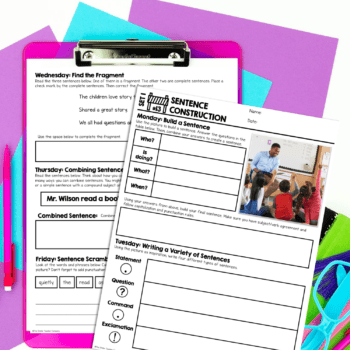
Incorporate Sentence Skills into Morning Routine:
Harness the power of routine by integrating sentence-level work into your morning routine. If your students already engage in daily morning tasks, seize this opportunity to include sentence writing. Whether adopting our suggested routine or introducing a scrambled sentence related to the day’s lesson, morning work becomes a consistent platform for sentence-focused activities.
A few ideas of what this could specifically look like:
- Use the sentence writing routine that I just mentioned during your morning work instead of as a warm-up to your literacy block.
- Have a scrambled sentence on the board related to something they are going to learn about during the day and they have to unscramble it.
- Ask students a question and give them a prompt with a specific type of sentence you want them to use when they reply. For example, you might ask “What was one good thing that happened to you over the weekend?” Then set the parameters for their response – write a complex sentence to respond.
This approach will give you and your students around 180 opportunities for improving sentence skills. Not too shabby, right?
Utilize Exit Tickets in Other Subjects:
Guess what? Students are writing all day, every day. Let’s make the most of it by sneaking in some sentence action into exit tickets for subjects beyond language arts. Have you tried a 3-2-1 exit ticket? A 3-2-1 exit ticket has students reflect on three things they learned, two important vocabulary words, and one question they still have. This strategy offers abundant opportunities for sentence-level skill practice. Challenge students to incorporate all four sentence types (statements, commands, questions, exclamations) in their responses, adding depth and complexity to their writing.

Leverage Reading Response Assignments:
Reading response assignments present another avenue to fortify sentence-writing skills. Equip students with a response frame, guiding them to complete a fragment using details from the text.
If you’re not familiar with what a response frame is, than I would encourage you to go back and listen to Episode #104 to hear all about the response frame and to get an idea of ones you can incorporate into your reading response.
Here’s a nifty trick we absolutely love using in our small group resources: prompting students to finish a fragment using details from the text. Instead of the usual routine of asking students a question and having them pen down the answer, we switch things up a bit. We hand them a fragment and challenge them to connect the dots, using details from the text to craft a complete sentence.
Why is this reading response prompt so fantastic? Let’s break it down.
Firstly, it’s not your run-of-the-mill comprehension exercise. It’s a sneak peek into students’ critical thinking skills. Take, for instance, the fragment: “…. are endangered because.” Now, the students aren’t just recalling facts; they’re diving into the text, identifying endangered species, and piecing together the reasons behind their endangered status. It’s a little more brainpower involved than your typical comprehension question.
But that’s not all – it’s a two-for-one deal! While assessing comprehension, this prompt also becomes a playground for reinforcing syntax and complete sentence construction. In the vast landscape of upper elementary writing, fragments tend to make frequent appearances. We want our students not just to spot them but also to wield the power to fix them up.
Remember, it’s not just about comprehension; it’s about flexing those critical thinking muscles too. Who knew sentences could be so sneaky yet so smart?
Share and Improve Written Responses with Feedback:
While practice is undeniably crucial, feedback is equally important. Whenever students share their written responses with the class, take the opportunity to provide constructive feedback.
When students either hear their response or read it aloud themselves, they become aware of mistakes they gloss over when they read it in their head. This practice helps them become more aware of errors that might be making and talk through how to correct them.
Feedback can focus on elements like punctuation, capitalization, phrase inclusion, sentence type identification, and suggestions for refining sentence structure. Regular feedback cultivates heightened awareness and thoughtfulness in sentence construction.

Incorporate Sentence Writing and Deconstruction into Read Alouds:
The read-aloud session serves as a treasure trove for sentence-level writing opportunities. Capitalize on this by integrating various activities.
- Task students with writing a sentence related to an image from the text.
- Identifying and deconstructing a sentence from the read-aloud text.
- Using the 5-W questions to craft an expanded sentence summarizing the text.
These activities seamlessly infuse sentence-level work into the immersive experience of a read-aloud session.
Daily Reflection for Sentence-Level Practice:
Wrap up the day with a breezy daily reflection – 5 to 7 minutes of sentence practice. Toss some sentence starters their way, ask them about their favorite part of the day or something they rocked at. Better yet, make it a team effort – have them share two sentences, then buddy up to combine their sentences with a partner. This reflective practice not only reinforces sentence-level skills but also provides a positive and constructive closure to the day.
This doesn’t have to be fancy, here are some simple sentence starters you can use:
- Today I learned…
- My favorite part of today was…
- I worked really hard on…
Or you might ask students to use the four sentence types to write about their day:
- Write an exclamation to celebrate a win.
- Write a command to share something they learned.
- Write a question they still have about the lesson.
- Write a statement that sets an intention for tomorrow.
As we bring this sentence series to a close, we hope that these seven intentional strategies will inspire you to seamlessly integrate sentence-level writing into various aspects of your instructional day. No need to overhaul your schedule – just sprinkle some sentence love into existing moments.
Just to review – here are the seven ways you can be more intentional about focusing on sentence-level work in your classroom.
- Incorporate a sentence-writing routine as a warm-up for your writing block.
- Incorporate sentence-level work into your morning work.
- Leverage your exit tickets in other subjects (especially if you use something like a 3-2-1) to focus on sentence writing.
- Utilize your reading response assignments to support sentence writing.
- Give students an opportunity to share and improve their written responses with the class
- Incorporate both sentence writing and sentence deconstruction into your read aloud
- Finally use a sentence-level daily writing reflection to close out your day.
Think about your next steps…
- If you feel inspired by this post, check out Episode 165 of the Stellar Teacher Podcast to learn more about these 7 sentence-level writing strategies and more!
- Challenge: Choose one of these strategies and start implementing it as soon as tomorrow! Make it simple and just go for it.
- Join us inside The Stellar Literacy Collective, where you will get access to a resource library filled with reading and writing resources that will help you save time and feel more confident in your ELA instruction.


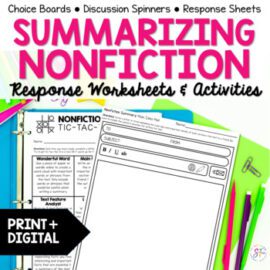
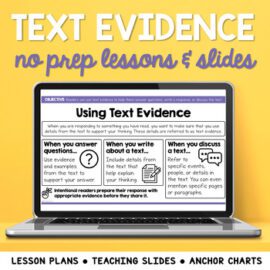
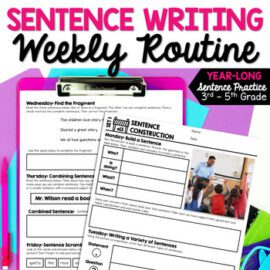
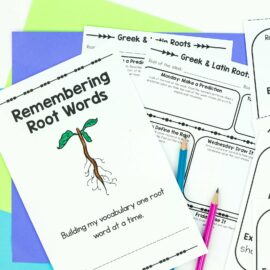











Leave a Comment
You must be logged in to post a comment.